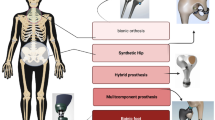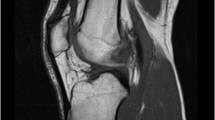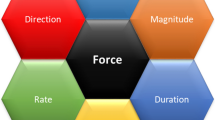Abstract
The ostrich (Struthio camelus) is characterized by high speed and heavy load when running. Its intertarsal joint (Fig. 1A) with double-nutrient foramina (DNF) exhibits excellent ability to withstand high impact during running, and is characterized by lightweight. We investigated the effect of DNF on the biomechanical properties of the intertarsal joints of the ostrich. The intertarsal joint was reconstructed according to computed tomography images, and four models were established to uncover the separate and combined effects of the compositional parameters (geometric features, material properties) on stress concentration reduction. We have revised the formula that can be used to predict the elasticity modulus (E) of ostrich bones and verified the accuracy of the formula with nano-indentation equipment. The results were analyzed by t tests, and the p value is less than 0.05. The finite element analysis was performed to evaluate the mechanical properties of the PT and models. Compared to the Filled model (DNF was filled), the maximum stress at the lateral and medial fossa in the Initial model was reduced by 15.4%, although there was no significant difference in the medial maximum stress. Compared with the stress value of models without holes, the models with holes have lower stress, with a reduction of 4.0%. Reasonable design of holes can improve the efficiency of material utilization. This paper investigated the mechanism of high mechanical properties of the intertarsal joints of ostrich and developed four bionic-bearing parts based on the characteristics of DNF and heterogeneity materials, which may provide ideas for the design of aircraft and robot parts with lightweight and high strength.

The intertarsal joint of ostrich and finite element models. a The intertarsal joint of ostrich. b The model which DNF was filled was named Filled model. c The model which DNF was retained was named Initial model
Graphic abstract





Similar content being viewed by others
References
Armstrong CG, Lai WM, Mow VC (1984) An analysis of the unconfined compression of articular cartilage. J Biomech Eng 106:165–173
Brekelmans WAM, Poort HW, Slooff TJJH (1972) A new method to analyse the mechanical behaviour of skeletal parts. J Acta Orthop Scand 43:301–317
Brooks DB, Burstein AH, Frankel VH (1970) The biomechanics of torsional fractures. the stress concentration effect of a drill hole. J Bone Jt Surg 52:507–514
Buskirk SR, Venkataraman S, Ifju PG, Rapoff AJ (2013) Functionally Graded Biomimetic Plate with Hole. 43rd Structures, Structural Dynamics and Materials Conference 1015–1021.
Carter DR, Hayes WC (1977) The compressive behavior of bone as a two-phase porous structure. J Bone Jt Surg Am 59:954–962
Cheraghi SH (2008) Effect of variations in the riveting process on the quality of riveted joints. Int J Adv Manuf Technol 39:1144–1155
Clark C, Morgan C, Sonstegard D, Sonstegard DA, Matthews LS (1977) The effect of biopsy-hole shape and size on bone strength. J Bone Jt Surg Am 59:213–217
Dabagov SB, Hampai D, Guglielmotti V et al (2020) X-ray applications and recent advances @ XLab Frascati. Rend Fis Acc Lincei 31:443–453
Edgerton BC, An KN, Morrey BF (1990) Torsional strength reduction due to cortical defects in bone. J Orthop Res 8:851–855
Fuss FK (1996) Tibiofibular junction of the South African Ostrich (Struthio camelus australis). J Morphol 227:213–226
Gangl D, Weissengruber GE, Egerbacher M, Forstenpointner G (2004) Anatomical description of the muscles of the pelvic limb in the ostrich (struthio camelus). Anatomia Histol Embryol 33:100–114
Gilbert MM, Snively E, Cotton J (2016) The tarsometatarsus of the ostrich struthio camelus: anatomy. Bone densities, and structural mechanics. PLoS ONE 11:e0149708
Goyat V, Verma S, Garg RK (2017) Reduction in stress concentration around a pair of circular holes with functionally graded material layer. Acta Mech 22:1045–1060
Ho KWK, Gilbody J, Jameso T, Miles AW (2010) The effect of 4 mm bicortical drill hole defect on bone strength in a pig femur model. Arch Orthop Trauma Surg 130:797–802
Högel F, Hoffman S, Panzer S et al (2013) Biomechanical comparison of intramedullar versus extramedullar stabilization of intra-articular tibial plateau fractures. Arch Orthop Trauma Surg 133:59–64
Huang Z, Jiang X, Liu H, Chen X, Huang Q (2018) Design of Crawling Motion for a Biped Walking Humanoid with 3-DoF Rigid-Flexible Waist. IEEE-RAS International Conference on Humanoid Robots. IEEE 974–979.
Kubair DV (2013) Stress concentration factors and stress-gradients due to circular holes in radially functionally graded panels subjected to anti-plane shear loading. Acta Mech 224:2845–2862
Kuindersma S, Deits R, Fallon M, Valenzuela A, Dai HK (2016) Optimization-based locomotion planning, estimation, and control design for the atlas humanoid robot. Auton Robot 40:429–455
Les CM, Stover SM, Keyak JH, Taylor KT, Willits NH (1997) The distribution of material properties in the equine third metacarpal bone serves to enhance sagittal bending. J Biomech 30:355–361
Lidor C, Ferris LR, Hall R, Alexander IJ, Nunley JA (1997) Stress fracture of the tibia after arthrodesis of the ankle or the hindfoot. J Bone Jt Surg 79:558–564
Martin RB, Gibson VA, Stover SM, Gibeling JC, Griffins LV (1996) Osteonal structure in the equine third metacarpus. Bone (new York) 19:165–171
Morgan EF, Bayraktar HH, Keaveny TM (2003) Trabecular bone modulus–density relationships depend on anatomic site. J Biomech 36:897–904
Nicole MV, Rospars JP (2016) Maximum relative speeds of living organisms: why do bacteria perform as fast as ostriches. Phys Biol 13:066006
Nie GJ, Batra RC (2019) Reducing stress concentration factor by strengthening circular hole with functionally graded incompressible material layer. Thin-Walled Struct 144:106223.1–106223.12.
Okazaki Y (2012) Comparison of fatigue properties and fatigue crack growth rates of various implantable metals. Materials 5(12):2981–3005
Pang H, Zhang H, Zhang R et al (2021) Design of the bionic wheel surface based on the friction characteristics of ostrich planta. Rend Fis Acc Lincei 32:191–203
Patak AE, Baldwin J (2015) Pelvic limb musculature in the emu Dromaius novaehollandiae (Aves: Struthioniformes: Dromaiidae): Adaptations to high-speed running. J Morphol 238:23–37
Sammarco GJ, Burstein AH, Davis WL, Frankel VH (1971) The biomechanics of torsional fractures: the effect of loading on ultimate properties. J Biomech 4:113–117
Sburlati R (2013) Stress concentration factor due to a functionally graded ring around a hole in an isotropic plate. Int J Solids Struct 50:3649–3658
Schaller NU, Herkner B, Villa R, Aerts P (2010) The intertarsal joint of the ostrich (Struthio camelus): Anatomical examination and function of passive structures in locomotion. J Anat 214:830–847
Schileo E, Dall’Ara E, Taddei F, Malandrino A, Schotkamp T, Baleani M, Viceconti M (2008) An accurate estimation of bone density improves the accuracy of subject-specific FE models. J Biomech 41:2483–2491
Schileo E, Taddei F, Malandrino A, Cristofolini L, Viceconti M (2007) Subject-specific FE models can accurately predict strain levels in long bones. J Biomech 40:2982–2989
Skorupa M, Skorupa A, Machniewicz T, Korbel A (2010) Effect of production variables on the fatigue behaviour of riveted lap joints. Int J Fatigue 32:996–1003
Tzena NG, Crossb AR, Ifjuc PG, Rapoff A (2003) Understanding stress concentration about a nutrient foramen. J Biomech 36:1511–1521
Venkataraman S, Haftka R, Rapoff AJ (2003) Structural optimization using biological variables to help understand how bones design holes. World Congress Struct Multidisc Optim 25:19–34
Wu Z, Lu J, Han B (1998) Study of residual stress distribution by a combined method of moiré interferometry and incremental hole drilling, part i: theory. J Appl Mech 65:837–843
Xue SL (2016) Bending characteristics and bionics of ostrich lower limb sacrum. D Jilin University.
Zeng GY (2014). FE modeling of ostrich foot movement system and its biomechanical function analysis. D Jilin University.
Zhang R, Han DL, Luo G, Ling L, Li GY, Ji QL, Li JQ (2017) Macroscopic and microscopic analyses in flexor tendons of the tarsometatarso-phalangeal joint of ostrich (Struthio camelus) foot with energy storage and shock absorption. J Morphol 279:302–311
Zhang R, Pang H, Han D et al (2020) Bionic design in anti-bending and lightweight tube based on the tarsometatarsus of ostrich. Rend Fis Acc Lincei 31:189–201
Acknowledgements
This work was supported by the National Natural Science Foundation of China (No. 51675221), the Graduate Innovation Fund of Jilin University (No.101832020CX156)
Author information
Authors and Affiliations
Contributions
The study conception was designed by Rui Zhang. Material preparation, data collection, and analysis were performed by Chengjin Wang, Lei Ling, Jianqiao Li and Ping Ge. The first draft of the manuscript was written by Chengjin Wang. The manuscript was revised by Rui Zhang and all authors commented on the early versions of the manuscript.
Corresponding author
Ethics declarations
Conflict of interest
The manuscript entitled “Light and High Strength Structure Inspired by the Characteristics of Double Nutrient Foramens in Intertarsal Joint of Ostrich” is no conflict of interests exists.
Additional information
Publisher's Note
Springer Nature remains neutral with regard to jurisdictional claims in published maps and institutional affiliations.
Rights and permissions
About this article
Cite this article
Zhang, R., Wang, C., Fan, S. et al. Light and high-strength structure inspired by the characteristics of double-nutrient foramens in intertarsal joint of ostrich. Rend. Fis. Acc. Lincei 32, 427–435 (2021). https://doi.org/10.1007/s12210-021-00998-y
Received:
Accepted:
Published:
Issue Date:
DOI: https://doi.org/10.1007/s12210-021-00998-y




